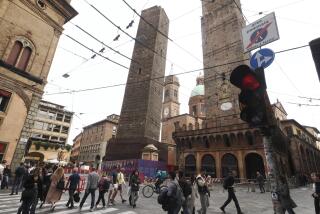900-Year-Old Bell Tower Collapses in Italy; Three Killed
- Share via
ROME — A 25-story, medieval bell tower collapsed without warning Friday into the main piazza of the northern Italian city of Pavia, killing at least three people and injuring about a dozen others.
Local firemen and police aided by civilian volunteers, Italian army specialists and sniffer dogs trained for earthquakes searched for victims through 30-foot high mounds of rubble that crushed a newspaper kiosk, damaged nearby shops, flattened part of a house and squashed cars parked in the town square.
“It’s a scene of war; hills of bricks and heaps of ancient masonry choking the piazza,” said Mino Milani, a writer who was about 100 yards away when the tower collapsed. “The city was thinking of restoring the tower, giving it new life as a museum. Instead, it chose sudden death,” Milani said by phone.
No Hint of Trouble
City officials said they had no hint that the tower was structurally unsound. There was some speculation that the tower’s foundation, eroded by centuries of water infiltration, had simply given way.
Built in 1060 and embellished by Renaissance architects in the 16th Century, the 255-foot red brick Torre Civica (civic tower) stood alongside a cathedral begun in 1488 atop two earlier Romanesque churches. The cathedral was slightly damaged in the tower’s collapse, officials said Friday night.
Ruins of one of the ancient churches served as part of the tower’s foundation and lower levels in a piazza that is the most popular meeting place in a city known for its medieval churches and a university founded in 1361. There are seven other feudal towers in Pavia.
As rescue work continued and cranes maneuvered with difficulty through narrow streets to reach the scene, police said the dead included a 52-year-old woman working in the kiosk, a local barber and a passer-by. Rescuers working into the night Friday believed that at least two people working in the area were still missing.
Stefano Gerardi, a Pavia merchant, told Italian reporters that he was buying his morning newspaper just before 9 a.m. when he saw bricks popping suddenly from the side of the tower. He dived for cover and urged the woman in the kiosk, Giuseppina Caselli, to flee. She was dialing the police when the tower collapsed on her kiosk.
“The furniture started dancing; we thought it was an earthquake,” said Umberto Barcella, who works in a city government office nearby.
Pavia, once the Roman trading center of Ticinum, and later the 6th-Century capital of the invading Lombard kings, is now a provincial capital and industrial center of about 90,000 citizens, about 22 miles southwest of Milan in the Po Valley.
More to Read
Sign up for Essential California
The most important California stories and recommendations in your inbox every morning.
You may occasionally receive promotional content from the Los Angeles Times.











